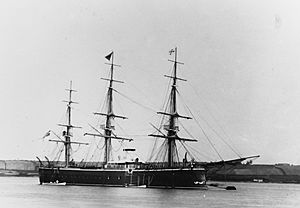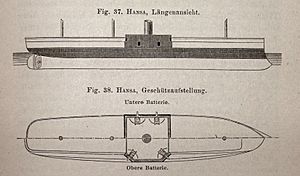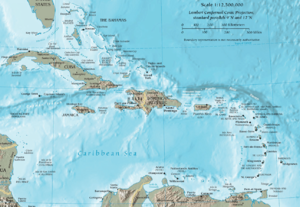SMS Hansa (1872) facts for kids

Hansa in Kiel in the 1880s
|
|
Quick facts for kids Class overview |
|
|---|---|
| Operators: | |
| Preceded by: | König Wilhelm |
| Succeeded by: | Preussen class |
| Completed: | 1 |
| Scrapped: | 1 |
| History | |
| Name | SMS Hansa |
| Builder | Kaiserliche Werft, Danzig |
| Laid down | 1868 |
| Launched | 26 October 1872 |
| Commissioned | 19 May 1875 |
| Stricken | 6 August 1888 |
| Fate | Broken up, 1906 |
| General characteristics | |
| Type | Armored corvette |
| Displacement | |
| Length | 73.50 m (241.1 ft) |
| Beam | 14.10 m (46.3 ft) |
| Draft | 5.74 m (18.8 ft) |
| Installed power | |
| Propulsion | |
| Sail plan | Ship rig, 1,760 m2 (18,900 sq ft) |
| Speed | 12 knots (22 km/h; 14 mph) |
| Range | 1,330 nmi (2,460 km; 1,530 mi) at 10 knots (19 km/h; 12 mph) |
| Boats & landing craft carried |
10 |
| Crew |
|
| Armament | 8 x 21 cm (8.3 in) L/19 guns |
| Armor |
|
The SMS Hansa was a special German warship built between 1868 and 1875. She was important because she was the very first armored ship made in Germany. Before her, all German armored ships were built in other countries. Her name, Hansa, came from the Hanseatic League, a powerful group of trading cities from long ago.
Hansa was launched in October 1872 and joined the German Imperial Navy in May 1875. She was designed to attack enemy forts from the sea. She was called an armored corvette, which is a type of small warship. Hansa was armed with eight large 21 cm (8.3 in) guns. These guns were placed in a special area in the middle of the ship, called a central battery.
In her early years, Hansa didn't see much action. She mostly took part in training exercises. From 1878 to 1880, she went on a long trip to Central and South America. During this time, she helped protect German people living there, especially during the War of the Pacific. By 1884, her iron hull was badly rusted. This meant she couldn't be used for fighting anymore.
After that, Hansa was used for other jobs. She was a guard ship in Kiel and helped train sailors who worked with engines and boilers. She even took part in more training exercises in 1885 and 1886. By 1888, she was in very poor condition. She was removed from the navy's list of active ships and became a barracks ship in Kiel. This means she was used as a floating home for sailors. In 1905, she moved to Mönkeberg and kept training boiler crews. Finally, in 1906, she was sold and taken apart for scrap metal.
Contents
Building the SMS Hansa
The idea for a small armored corvette started way back in 1861. This was soon after the first ironclad warships, which were ships covered in metal armor, began to be used by the British and French navies. The Prussians, who later became part of Germany, first thought about using these armored ships to attack forts along the coast. This was similar to how French armored ships had been used in the Battle of Kinburn in 1855.
Work on this new ship idea moved slowly. At first, the Prussians bought several armored ships from shipyards in Britain and France. Over time, the design for Hansa changed. It ended up looking like a casemate ship, which is a type of armored ship with its guns in a protected central area. It was similar to a British ship called HMS Pallas.
How Hansa Was Built
Hansa was laid down, meaning her construction began, at the Royal Dockyard in Danzig on November 16, 1868. She was the very first armored warship built in a German shipyard. All the armored ships before her had been built in other countries like France and Britain.
Building Hansa took a long time. One reason was that the wood used for her hull needed to dry properly. Another reason was the Franco-Prussian War that happened from 1870 to 1871. The ship was finally launched on October 26, 1872. A general named Hermann von Tresckow gave a speech at the launch. This was the first time such a speech was given for a Prussian or German warship.
After launching, she was taken to another shipyard in Stettin for more work. This was finished in December 1874. Then, she was towed to Swinemünde. From there, she was supposed to sail to Kiel. On December 16, while trying to leave Swinemünde, the ship got stuck on the ground. She wasn't damaged, but she had to go back to port. She finally arrived in Kiel on January 3, 1875.
Hansa was officially ready for service and joined the German fleet on May 19, 1875. This was two and a half years after she was launched! Other armored ships built in foreign shipyards were finished much faster. The delays with Hansa happened because the German shipyards were still learning how to build these complex armored warships.
Hansa's Design and Features
Hansa was about 73.50 m (241.1 ft) long. She was 14.10 m (46.3 ft) wide and went about 5.74 m (18.8 ft) deep into the water. The ship was designed to weigh about 3,950 metric tons (3,890 long tons; 4,350 short tons) when normally loaded. Her hull, or body, was made with iron frames and a mix of iron and wood. The part of the hull underwater was covered with copper. This helped stop plants and animals from growing on it, which could slow the ship down. The hull also had six special sections that could be sealed off to prevent flooding.
Sailors found that Hansa was very steady in the water. She was easy to steer with her single rudder. She could turn well, especially when using her sails. Even with her steam engine, she remained easy to control. The ship had a crew of 28 officers and 371 enlisted men. She also carried several smaller boats for different tasks.
Hansa used a single steam engine built in Stettin. This engine powered a large, three-bladed propeller that was 6 m (20 ft) wide. Four boilers created the steam for the engine. These boilers were in one room and sent their smoke up a single large funnel. This funnel could be lowered when the ship was using its sails. The engine could make the ship go up to 12 knots (22 km/h; 14 mph) (knots), which is about 22 km/h (14 mph). Hansa carried 310 t (310 long tons; 340 short tons) of coal for her boilers. This gave her a range of about 1,330 nautical miles (2,460 km; 1,530 mi) (nautical miles) when cruising at 10 knots (19 km/h; 12 mph). She also had a full set of sails to help her move, covering an area of 1,760 m2 (18,900 sq ft).
Guns and Armor
Hansa was armed with eight large 21 cm (8.3 in) guns. Each gun had 110 rounds of ammunition. These guns were placed in a special two-story setup in the middle of the ship. Four guns were on each side of the ship in a protected area called a casemate. The other four guns were at the corners of the lower casemate. This allowed the ship to fire some guns forward or backward, not just to the sides. The lower guns could aim down to -5 degrees and up to 13 degrees, reaching targets up to 3,200 m (3,500 yd) away. The upper guns could aim down to -8 degrees and up to 14 degrees, with a longer range of 5,700 m (6,200 yd).
Hansa's armor was made of wrought iron plates from Great Britain, backed by strong teak wood. Her main armor belt was 152 mm (6 in) thick in the middle, protecting the most important parts of the ship. At the front and back, the belt was a bit thinner, at 114 mm (4.5 in). The entire belt had 306 mm (12 in) of wood behind it. The casemates, where the guns were, had 114 mm (4.5 in) thick iron plates that sloped to deflect shots. The lower casemate also had thick armored walls at its ends.
Hansa's Service History
In the 1870s, German armored ships usually served actively during the summer. In winter, most ships were put into reserve. Hansa joined the summer Training Squadron in 1875. This group included other ironclads like SMS Kronprinz and SMS Kaiser. The ships stayed in German waters and visited Rügen in July. They also did training exercises in Danzig Bay. After a naval review for Kaiser Wilhelm I, Hansa was taken out of service on November 4.
Overseas Adventures
Hansa remained out of service until July 22, 1878. She was then prepared for a trip to the West Indies. She left Kiel on October 31 and arrived in Charlotte Amalie on January 3, 1879. There, she received orders to sail to Venezuela. There was unrest in Venezuela, which put Europeans living there at risk.
In Venezuela, Hansa met another German ship, SMS Nymphe. Both ships helped protect German citizens in Puerto Cabello. They also helped American citizens in La Guaira. While in La Guaira, Hansa's engines broke down. The crew quickly used the sails to avoid hitting other ships. SMS Nymphe left, but Hansa stayed until February 20, when the unrest seemed to be ending.
After Venezuela, Hansa visited Curaçao and other islands in the Greater Antilles. She also stopped in Greytown, Nicaragua, Colón, and Saint Thomas. From Saint Thomas, she sailed south to visit South America's east coast. In Bahia, she received new orders to go to the west coast of South America.
The War of the Pacific had started between Peru, Chile, and Bolivia. This war threatened the safety of Germans and other foreigners. Hansa arrived in Valparaiso, Chile, on August 19. She then went to Callao, Peru. The Peruvian government had seized a German ship for carrying illegal goods. Hansa took the German crew aboard, but couldn't get the ship released. The commander of Hansa was told to stay neutral and didn't have enough power to take direct action. Other German ships, SMS Freya and SMS Hyäne, were sent to help Hansa.
After Chile won the Battle of Angamos, they planned to attack Callao. Hansa's commander protested, and Chile canceled the attack. Hansa patrolled the Peruvian and Chilean coasts until June 1880. She often sent landing parties ashore in cities like Callao and Lima to protect Germans. More German ships arrived, and as Chile won the war, the other German ships were sent home. Hansa began her journey home in July, arriving back in Kiel on October 22. She was then taken out of service on November 8.
Later Years and Final Fate
After her long trip, Hansa was repaired and stayed out of service until February 1884. She was then put back into service on February 22, 1884. Her new job was to be a guard ship in Kiel and a training ship for sailors working with boilers and engines. She took several short training trips. In June, Prince Wilhelm and Prince Heinrich, the Kaiser's grandsons, cruised on her with the Ironclad Training Squadron.
By early 1888, it was clear that Hansa's hull was badly rusted. This was partly because of how long it took to build her, as the iron had started to rust even then. She was officially removed from the navy's list of ships on August 6, 1888. By this time, her hull was so bad that she couldn't go to sea anymore.
Hansa was then changed into a floating barracks in Kiel. This meant she became a floating home for sailors of the II Torpedo Division. They even added central heating and electric lights! She served in this role until 1905. Then, Hansa was moved to Mönkeberg. She was stripped down and used to train sailors who worked with boilers. She didn't last long in this job. In March 1906, she was sold for 96,000 German marks. Later that year, Hansa was taken apart for scrap metal in Swinemünde.
Images for kids
-
Hansa in Kiel




